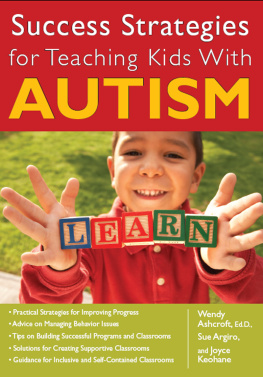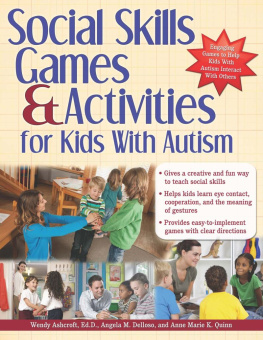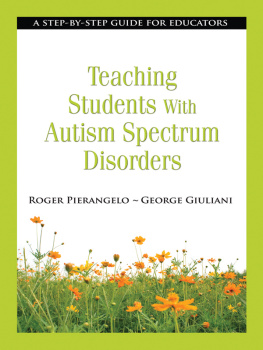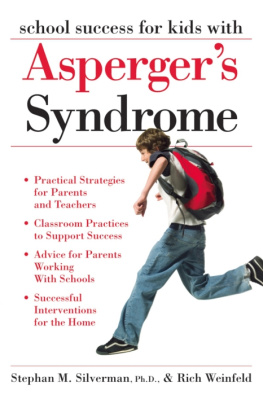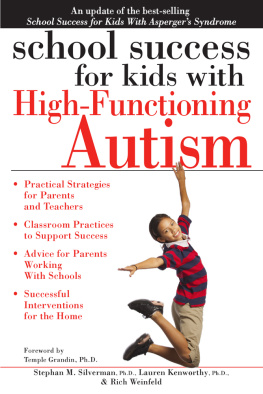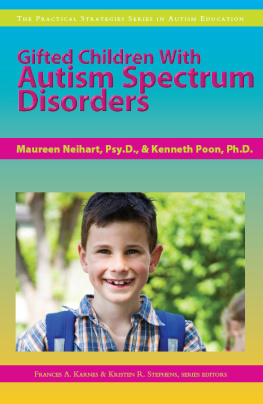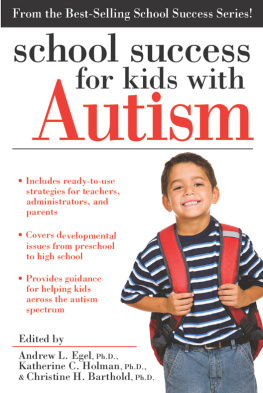Library of Congress Cataloging-in-Publication Data
Copyright 2010, Prufrock Press Inc.
Edited by Lacy Compton
Cover and Layout Design by Marjorie Parker
ISBN-13: 978-1-59363-754-5
No part of this book may be reproduced, translated, stored in a retrieval system, or transmitted, in any form or by any means, electronic, mechanical, photocopying, microfilming, recording, or otherwise, without written permission from the publisher.
Printed in the United States of America.
At the time of this books publication, all facts and figures cited are the most current available. All telephone numbers, addresses, and Web site URLs are accurate and active. All publications, organizations, Web sites, and other resources exist as described in the book, and all have been verified. The authors and Prufrock Press Inc. make no warranty or guarantee concerning the information and materials given out by organizations or content found at Web sites, and we are not responsible for any changes that occur after this books publication. If you find an error, please contact Prufrock Press Inc.
 |
Prufrock Press Inc. P.O. Box 8813 Waco, TX 76714-8813 Phone: (800) 998-2208 Fax: (800) 240-0333 http://www.prufrock.com |
CONTENTS
WHAT IS AUTISM?
A parent of a child with autism, in an anonymous posting on the Internet, describes autism as:
Always
Unique,
Thoroughly
Intriguing, and
Sometimes
Mysterious.
In the same passage, the author states that autism has brought Anger and rage, Unbelief and denial, Tears and sadness, Isolation and loneliness, and then Solace and peace. The author ends with thoughts of rejoicing in the childs successes and delighting in the childs Magic smile (Lets Beat Autism Now, n.d.; see http://www.letsbeatautismnow.com/Poems.html for similar parent writings on this disorder).
In our experiences as teachers, we have found children with autism to be wonderful and fascinating. We have been privileged to participate in the many amazing achievements of our children and we have celebrated with their families. But, we also have shared in some of the pain, sorrow, and frustration experienced by the families and, perhaps most importantly, we have learned much from the challenges of helping children with this puzzling condition.
Autism is a complex spectrum disorder characterized by impairments in social interaction, communication, and behavior. The label autism spectrum disorder (ASD), an umbrella term, frequently is used to describe a continuum of features ranging from mild to severe. Each person with a diagnosis of ASD has a unique combination of characteristics related to verbal and nonverbal language (communication), interacting with others (social skills), and repetitive, narrow, and restricted interests (behavior). In individuals, these characteristics are presented in varying degrees of severity and result in different levels of functioning.
Autism spectrum disorders are considered to be neurobiological and generally are diagnosed by a team of professionals, including medical personnel. They also are described as developmental disabilities, meaning they usually are evident by 3 years of age. These neurobiological, developmental diagnoses of ASDs have lifelong influences on how individuals communicate their ideas and feelings, how they develop relationships with others, and how they participate in their environments.
The term ASD often is used interchangeably with Pervasive Developmental Disorder (PDD). PDD also is an umbrella term (see ) encompassing the five disorders in the text revision of the fourth edition of the Diagnostic and Statistical Manual (DSM-IV-TR; American Psychiatric Association, 2000). Sometimes, ASD is used to refer only to three of the disorders: autism, Aspergers syndrome, and Pervasive Development Disorder-Not Otherwise Specified (PDD-NOS). The prognosis for each of these three disorders is quite favorable in that, with effective treatment, individuals make significant progress. Other times, ASD also is considered to encompass two other disorders: Rett syndrome and childhood disintegrative disorder. Both of these are progressive disorders, describing individuals who start with a period of typical development and then enter a regressive phase. The prognosis for these two disorders is not as promising.

The various disorders included in the umbrella term, Pervasive Developmental Disorder.
In the following pages, additional information is provided for each of the five disorders. Descriptions of children are presented to help explain how the disorder may affect individuals.
AUTISM
Autism (also called autistic disorder) is a complex condition diagnosed by observation and analysis of a persons behavior patterns. It is a spectrum disorder, meaning it includes individuals with widely varying abilities and unique combinations of behavioral deficits and excesses. A complete evaluation of language, cognition, and behavior, as well as physical and neurological assessments, are necessary for a formal diagnosis. A good evaluation process involves consultations from a physician, psychologist, and speech-language pathologist, and parent information regarding developmental history and current functioning.
There is general agreement that autism is a neurological disorder affecting brain functioning and that it is a developmental disorder, usually diagnosed before the age of 3. People with autism often have difficulty with verbal and nonverbal communication and social interactions along with restricted interests, repetitive behaviors, and resistance to change.
Case Study of Autism: Mark
Mark was diagnosed with autism at age 2. From birth he had typical development, sitting at about age 6 months and walking at about a year. At 14 months he was consistently imitating sounds and actions, verbalizing while pointing to things he wanted and babbling. He clearly asked for mama, daddy, ball, and play, and occasionally put two words together like Daddy go. By 18 months he was walking on his tiptoes, wringing his hands, and crying instead of communicating. He no longer used understandable words and he stopped interacting with people.
When Mark was diagnosed, he had significant delays in social interaction such as avoiding eye contact and running away from people. Not only did he lose his ability to communicate with others, he showed no understanding of spoken language. He did not follow even simple directions. Between the ages of 2 and 3, Mark developed very frequent hand movements such as wringing his hands and twisting his fingers. His interest in toys was limited to waving them in front of his eyes.
At age 3, Mark began receiving intensive Discrete Trial Training (DTT) and quickly regained his ability to follow directions. He also learned to match and to name objects and pictures. In spite of intensive interactive instruction, Mark continued to show little interest in communicating with people. His restricted interests limited his opportunities to play with his brothers and yielded even fewer activities with neighbors and schoolmates. By age 6, Marks expressive vocabulary was more than 1,000 words; however, he still had little interest in interacting with others and often communicated with whining and crying rather than talking.
Next page
